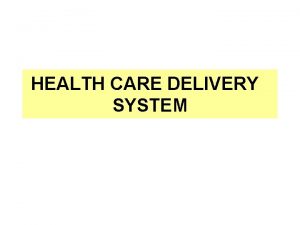Primary Healthcare Delivery First Nations Inuit e Health







- Slides: 7

Primary Healthcare Delivery First Nations & Inuit e. Health Ernie Dal Grande, National e. Health Program Manager, First Nations and Inuit Health Branch, Health Canada

e. Health Defined: United Nations WHO • “The use of information and communication technology in the health sector (digital data transmitted, stored and retrieved electronically for clinical, educational and administrative purposes, both at the local site and at a distance)” (WHO HQ 2002; Mitchell 1999).

Why e. Health? • • • Better health care and health for all by improving citizen access to health care any where they live, while providing good quality health information to help individuals make informed decisions Improve the decision-making process by empowering health care professionals with the information required to plan and deliver health care service Improve health system administration and management with quality information (planning, monitoring, allocation of funds, evaluation)

Some of the Main e. Health Components • Health Information for the Public • Electronic Health Record/Electronic Medical Record • Telehealth/Telemedicine/Telecare • Public Health Surveillance systems • Drug Information Support • Diagnostic Imaging • Laboratory Systems • Registries • Privacy Protection • Standards

e. Health Summarized Ø Telecommunications (increasing demand for more bandwidth, start with what you can afford and increase over time as utilization goes up) Ø Point of Service Technologies (wide range of enabling tools, fully integrated to meet broad business needs) Ø Technology Support/Expertise ( health professionals are busy enough without having to worry about IT) Ø Health Service Delivery People ( need to see value to doing daily business electronically-must change mind set and business processes) Ø Health Organization Partnerships (partnerships help with integration and data sharing- e. Health is breaking down traditional jurisdictional boundaries) Ø Private Sector and NGO Involvement (this expertise is a vital part of transition and change management) Ø Business Process/Protocols (forcing the health sector to improve efficiency and update ICT and data management policy, regulations, laws)

e. Health Lesson Learned • That e-Health deployment is a strategic business issue rather than a technology issue. Business needs and overall ‘Health System’ costs drive e-Health deployment as the “Enabler of Change” • Be prepared to deal with Political, Technological, Financial, Organizational and Human Challenges • You must believe in the cause and stay with it. It will take time, effort and resources and it is a continuous learning process, with mistakes and corrections part of the journey • e-Health encompasses two distinct but interdependent components: Information Management and Information Technology

Contact Ernie Dal Grande National e. Health Program Manager First Nations and Inuit Health Branch Health Canada Ottawa ernie_dal_grande@hc-sc. gc. ca 613 -954 -1736











